How to Grow a Nutmeg Tree: Essential Tips for a Thriving Spice Plant
- March 21, 2024
- 0 comment
Learn how to grow a Nutmeg tree (Myristica fragrans) with our guide. Cultivate this tropical evergreen for fresh spices and lush garden greenery. Growing a nutmeg tree can be a rewarding experience, providing not only a source of fresh spices but also adding a lush, green element to your garden. Here’s how you can grow your own nutmeg tree.
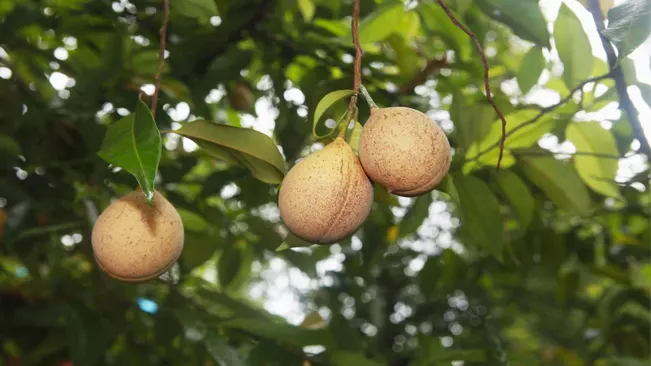
Benefits of Nutmeg
| Benefit | Description |
|---|---|
| Culinary Uses | Nutmeg is widely used as a spice in various cuisines, offering a warm, sweet flavor to dishes like pies, puddings, soups, and savory dishes. |
| Medicinal Properties | Nutmeg has been used in traditional medicine for its potential digestive, anti-inflammatory, and analgesic properties. |
| Essential Oil Production | Nutmeg essential oil, extracted from the seed, is used in aromatherapy and has potential benefits in relieving pain, inflammation, and stress. |
| Ornamental Value | The nutmeg tree, with its glossy green leaves and attractive fruit, can serve as an ornamental plant in suitable climates. |
| Economic Significance | Nutmeg is a valuable crop in the spice trade. Cultivating nutmeg trees can contribute to local economies, especially in tropical regions where it’s a native crop. |
| Environmental Benefits | Being an evergreen tree, it contributes to carbon sequestration and provides habitat for various species of birds and insects. |
| Cultural Importance | Nutmeg has historical and cultural significance in many regions, often associated with holiday seasons and traditional remedies. |
| Mace Spice Production | The red aril (mace) covering the nutmeg seed is also a valuable spice, offering a slightly different flavor profile than nutmeg and used in various culinary dishes. |
List on How To Grow a Nutmeg Tree
- Understanding Nutmeg Trees
- Climate and Soil Requirements
- Planting Nutmeg
- Caring for Your Nutmeg Tree
- Pollination
- Pest and Disease Management
- Harvesting
- Processing and Storage
Understanding Nutmeg Trees
The Dioecious Nature of Nutmeg Trees
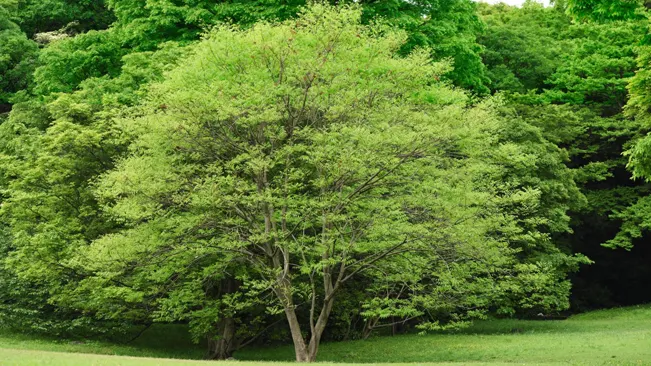
Nutmeg trees, with their scientific name Myristica fragrans, are intriguing because of their dioecious nature. This term means that the species has distinct male and female plants.
- Male Trees: They produce pollen necessary for fertilizing the female flowers. However, they do not bear any fruit.
- Female Trees: These are the ones that produce the fruit. The fruit is where the valuable nutmeg seed, along with mace, another spice, is found.
Significance of Dioecy in Cultivation
- In a nutmeg orchard, it’s essential to have an adequate number of male trees to ensure pollination of the female trees. Generally, a ratio is maintained – for example, one male tree for every 10 to 15 female trees. This ensures effective pollination and, consequently, fruit production.
The Fruits and Seeds
- When ripe, the fruit splits open, revealing a bright red, lacy aril known as mace, enveloping a brown, hard-shelled nutmeg seed.
- Both nutmeg (the seed) and mace (the aril) are valuable spices. Mace has a slightly more delicate flavor compared to the more robust nutmeg.
Longevity and Maturation
- Maturation: They take approximately 7 to 9 years to start producing fruit, depending on the growing conditions.
- Longevity: Once they begin bearing fruit, they can be productive for many decades, often up to 60 years or more.
Ecological and Economic Importance
- Biodiversity: In their native ecosystems, nutmeg trees contribute to the biodiversity, offering habitat and food for various wildlife species.
- Economic Value: Nutmeg is a highly valued spice in international markets. The tree’s ability to produce two distinct spices (nutmeg and mace) adds to its economic significance.
Climate and Soil Requirements
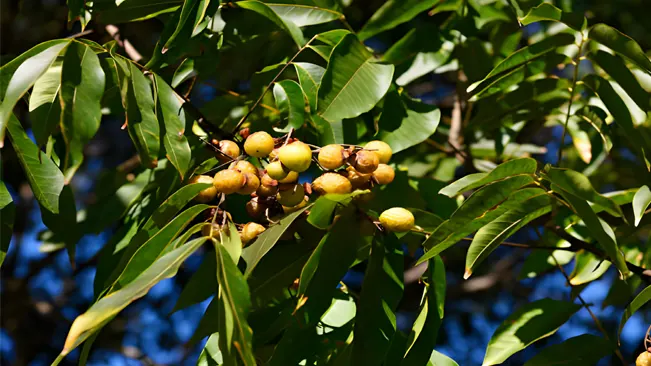
Climate Requirements for Nutmeg Trees
- Temperature Range: Nutmeg trees thrive in a consistently warm climate. The ideal temperature range is between 25-30°C (77-86°F). They are tropical plants and do not fare well in cooler temperatures. Even brief exposure to frost can be detrimental to these trees.
- Humidity: High humidity is crucial for nutmeg trees. They originate from rainforest environments, which are naturally very humid. This level of moisture in the air is important for their growth and fruit production.
- Sunlight and Shade: While they do need sunlight, nutmeg trees also benefit from partial shade, especially in the younger stages of growth. This mimics their natural environment under the canopy of larger trees in the rainforest.
- Rainfall: Regular and abundant rainfall is another key factor. Nutmeg trees require a lot of water, but it’s crucial that this water doesn’t lead to waterlogging.
Soil Requirements for Nutmeg Trees
- Soil Type: The best soil type for nutmeg trees is rich, loamy soil. Loam is a mixture of sand, silt, and clay, providing excellent drainage as well as sufficient nutrients and moisture retention for the trees.
- Soil pH: The ideal pH level for nutmeg trees is slightly acidic to neutral, ranging from 6.0 to 7.0. It’s important to regularly check the soil pH, as extreme variations can affect the nutrient uptake and overall health of the tree.
- Drainage: Good drainage is essential. Nutmeg trees do not tolerate waterlogged conditions, which can lead to root rot, a serious condition that can severely damage or kill the tree. Ensuring the planting site has good drainage will help prevent this.
- Nutrient Content: Nutmeg trees benefit from soil that is rich in organic matter. Incorporating compost or aged manure into the soil can boost its fertility and structure, providing the tree with the necessary nutrients for growth and fruiting.
Planting Nutmeg
Growing a nutmeg tree begins with the propagation of its seeds. Since nutmeg trees are propagated sexually, they produce seeds that can be planted to grow new trees.
Seed Selection
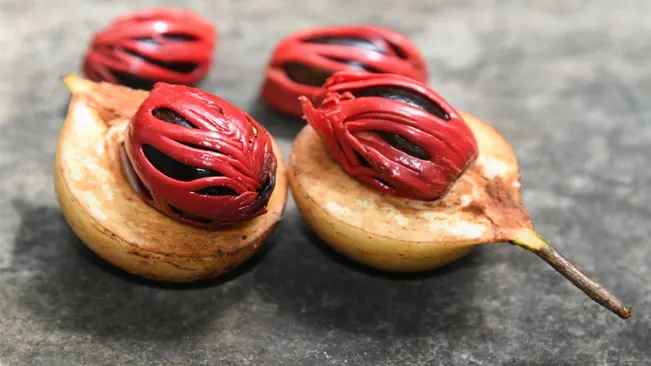
- Freshness: It’s important to use fresh seeds for propagation. Nutmeg seeds lose viability quickly, so the fresher the seeds, the better the germination rate.
- Source: Ideally, select seeds from a healthy, productive nutmeg tree. The fruit should be fully mature and have a yellowish-brown color.
Seed Preparation

- Once you have the fruit, carefully open it to extract the seed. The seed is encased in a bright red aril, known as mace, which is also a valuable spice.
- Remove the mace from around the seed. You can dry and store the mace for culinary use.
- Clean the seed gently to remove any pulpy fruit residue.
Germination Process
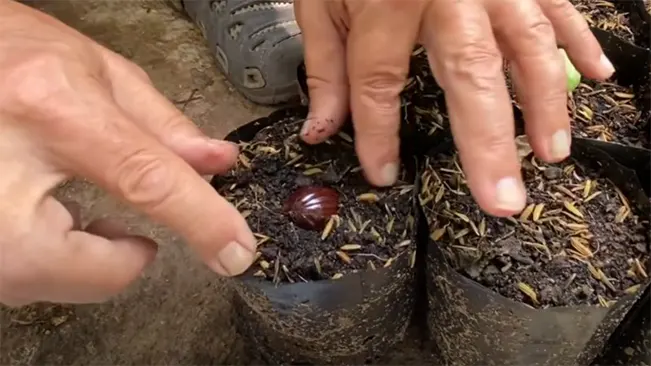
- Soil Preparation: Use a seedling tray filled with a mixture of soil, compost, and sand to ensure good drainage and fertility.
- Planting Depth: Sow the seeds about 2-3 cm deep. This depth is ideal for providing the necessary darkness and stability for germination while allowing the emerging shoot to reach the surface.
- Moisture: Keep the soil consistently moist but not waterlogged. Over-watering can lead to fungal diseases or rot.
- Warmth: Nutmeg seeds need a warm environment to germinate. A temperature around 25-30°C (77-86°F) is ideal. If you’re in a cooler climate, consider using a greenhouse or a warm indoor spot.
Seedling Care
- Sunlight: Initially, keep the seedlings in a shaded area as they are sensitive to direct sunlight.
- Transplanting: Once the seedlings have developed a few sets of leaves and are strong enough, they can be transplanted. This usually happens when they are a few months old.
- Spacing: When transplanting into the ground, ensure adequate space between the trees – about 9-12 meters apart. Nutmeg trees can grow quite large, and sufficient space is necessary for healthy growth.
Growth Monitoring
- Regularly check the seedlings for signs of pests or diseases. Early detection and treatment are key to healthy growth.
- Nutmeg trees are slow growers. Patience is essential as it will take several years before they mature and start bearing fruit.
Caring for Your Nutmeg Tree
Watering
Nutmeg trees require consistent moisture for healthy growth, especially in their formative years. Regular watering is vital, but the amount and frequency depend on the climate and soil type.
- Frequency: In general, water the tree once a week. During hotter, drier periods, more frequent watering may be necessary.
- Amount: Ensure the soil is moist but not waterlogged. About 2 inches of water per week is a good guideline.
- Mulching: Applying mulch around the base of the tree can help retain soil moisture and regulate soil temperature.
Sunlight
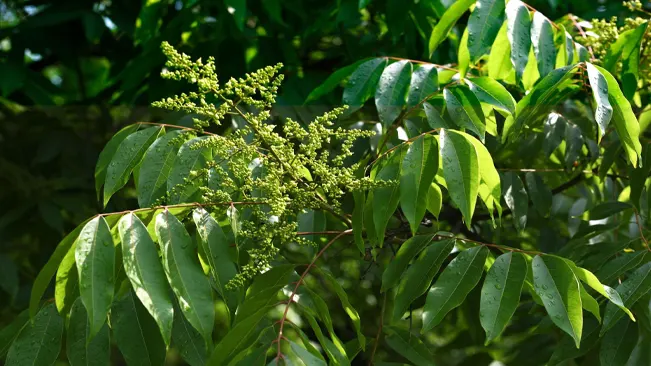
- Young Trees: They thrive in partial shade. This helps protect the tender young plants from the harshness of direct sunlight.
- Mature Trees: As they grow, they can tolerate and even benefit from more direct sunlight. However, in very hot climates, some afternoon shade is still beneficial.
Fertilizing
- Type of Fertilizer: Use organic fertilizers like compost, manure, or a balanced NPK (Nitrogen, Phosphorus, Potassium) fertilizer.
- Frequency: Apply fertilizer annually. The best time is usually at the beginning of the growing season.
- Application: Spread the fertilizer evenly around the base of the tree, extending out to the drip line (the area directly below the outer circumference of the tree branches), and then water it in.
Pruning
- Timing: The best time to prune is during the dormant season, though removing dead or diseased branches can be done any time of the year.
- Objectives: Pruning should aim to remove dead or diseased branches, thin out overcrowded branches to improve air circulation, and shape the tree for aesthetic or practical reasons (like height control).
- Technique: Use clean, sharp pruning tools. Make cuts at a 45-degree angle to avoid water accumulation on the cut surface, which can lead to rot.
Pollination
As they are dioecious, if you’re growing nutmeg for fruit production, you’ll need both male and female trees. One male tree is sufficient to pollinate several female trees.
Understanding Dioecious Plants
- Dioecious Defined: In botanical terms, “dioecious” refers to plant species where individual plants are either male or female. This is unlike “monoecious” plants, where a single plant bears both male and female flowers.
- Implication for Nutmeg Trees: In the case of nutmeg, each tree is distinctly male or female. The male trees produce pollen, and the female trees produce the fruit, which houses the valuable nutmeg seed.
The Role of Male and Female Nutmeg Trees
- Male Trees: These trees are essential for pollen production. They bear small, inconspicuous flowers that generate pollen but do not produce fruit.
- Female Trees: The female nutmeg trees bear the fruits. These fruits are the source of nutmeg seeds (the actual “nutmeg”) and mace, another spice derived from the red aril enveloping the seed.
Pollination Process
- Natural Pollination: In their native habitat, nutmeg trees are primarily pollinated by wind and, to a lesser extent, by insects. The male trees release pollen into the air, which then needs to reach the female flowers to initiate fruit development.
- Human Intervention: In cultivated settings, especially where nutmeg trees are grown for commercial spice production, manual pollination is sometimes practiced. This involves transferring pollen from male flowers to female flowers by hand, ensuring a higher rate of pollination and fruit set.
Practical Aspects for Growers
- Ratio of Male to Female Trees: A common practice is to grow several female trees with a few male trees interspersed among them. Typically, one male tree can effectively pollinate about 10 to 12 female trees.
- Identifying Sex of Trees: It can be challenging to determine the sex of a nutmeg tree until it reaches flowering age, which can be several years after planting. Some growers plant more trees initially and thin them out once they can identify their sex.
- Pollination Efficiency: Ensuring that male and female trees are within proximity to each other enhances the chances of successful pollination, especially in the case of wind pollination.
Pest and Disease Management
Nutmeg trees, while resilient, can fall prey to certain pests and diseases. Understanding and managing these issues is crucial for maintaining the health and productivity of your trees.
Common Pests
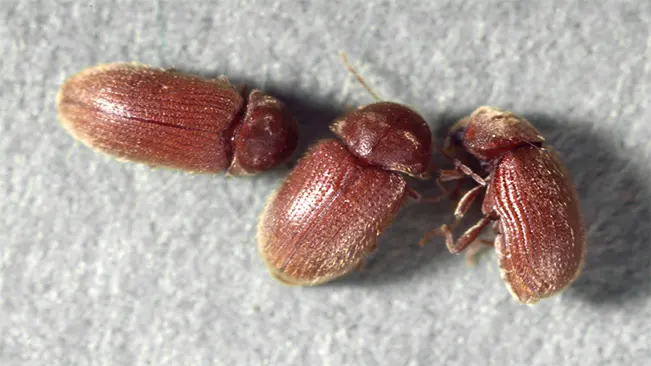
- Nutmeg Grinders (Stegobium paniceum): These small beetles can cause significant damage by boring into the seeds. Infestation signs include small holes in the nutmeg seeds and the presence of fine powder.
- Fruit Flies: They lay eggs in the developing fruit, and the larvae feed on the flesh, leading to fruit decay.
- Mites and Scale Insects: These pests can attack the leaves and stems, sucking the sap and weakening the tree.
Pest Management Strategies
- Regular Inspection: Regularly inspect your trees for signs of pests. Early detection is key to effective control.
- Cultural Practices: Keep the area around the trees clean and free of debris where pests can breed.
- Biological Control: Introduce natural predators or parasitoids that can help control pest populations.
- Organic Pesticides: Neem oil, horticultural oils, or insecticidal soaps can be effective against a range of pests. They are less harmful to the environment compared to synthetic pesticides.
Common Diseases
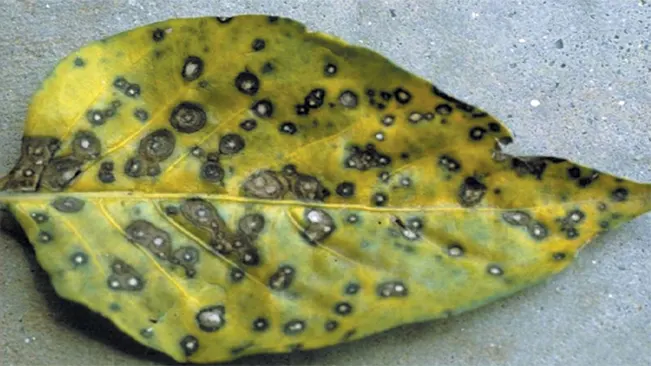
- Leaf Spot (Phytophthora spp., Colletotrichum spp.): This fungal disease causes brown or black spots on leaves, leading to leaf fall. It’s more prevalent in humid conditions.
- Root Rot: Caused by overly wet soil conditions, leading to decay of the roots.
- Seedling Blight: Affects young plants, causing damping-off or rot at the base of the stem.
Disease Management Strategies
- Fungicides: Apply organic fungicides as a preventive measure, especially in humid conditions.
- Proper Irrigation: Ensure good drainage and avoid over-watering to prevent root rot and other moisture-related diseases.
- Sanitation: Remove and destroy infected plant parts to reduce disease spread. Avoid working with wet plants to prevent the spread of fungal spores.
Harvesting
Before discussing the harvest, it’s important to understand what the nutmeg fruit is like. The fruit of the nutmeg tree is fleshy and pear-shaped, resembling an apricot in size. When it ripens, it splits open to reveal a vibrant red aril, known as mace, which envelops the hard-shelled nutmeg seed.

When to Harvest
- Timeframe: Nutmeg trees start bearing fruit approximately 7-9 years after planting. This timeframe can vary depending on the growing conditions and the tree’s health.
- Indicators: The key indicator for harvest readiness is the fruit itself. When ripe, the nutmeg fruit splits open. This natural splitting is a clear sign that the fruit, and more importantly, the seed inside, is ready for harvest.
The Harvesting Process
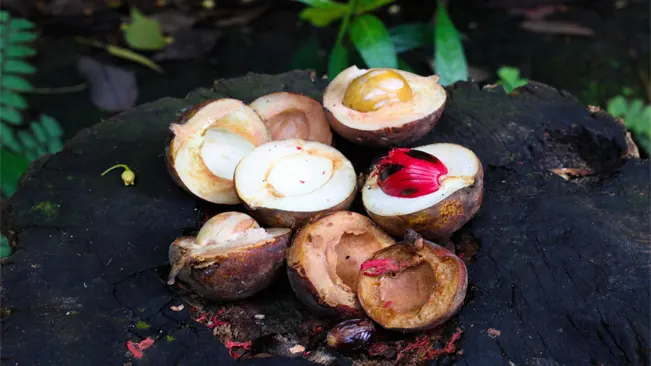
- Plucking the Fruit: Once the fruit splits, it should be plucked from the tree. This should be done carefully to avoid damaging the mace and the seed inside.
- Extracting the Seed: After plucking, the next step is to gently extract the nutmeg seed from the fruit. The red mace is carefully peeled away from the hard shell of the nutmeg.
- Curing the Mace and Seed:
- Mace: The mace, once removed, is flattened and dried. It can be sun-dried or air-dried in a well-ventilated area. This process intensifies its flavor and prepares it for storage or spice production.
- Nutmeg Seed: The seed, still in its hard shell, needs to be dried as well. This is often done in the sun and can take several weeks. The drying process is crucial as it helps in developing the nutmeg’s distinct flavor and aroma. When the seeds rattle inside their shell, it indicates they are adequately dried.
- Shell Removal and Storage: After drying, the hard shell is cracked to reveal the nutmeg seed. The seeds are then stored or ground into nutmeg powder.
Processing and Storage
Drying Process
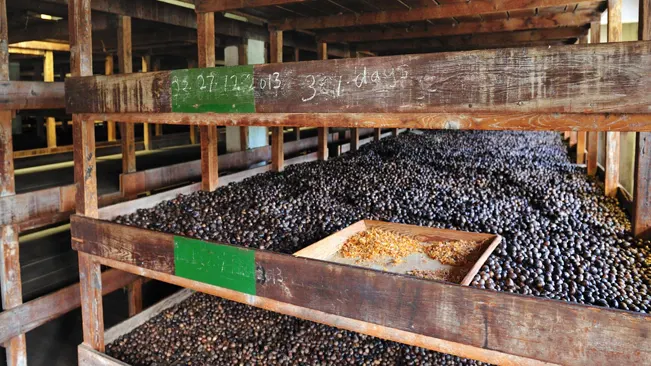
- Separating Mace and Nutmeg: Once the nutmeg fruits are harvested, the first step is to remove the mace, which is the bright red, lace-like covering that encases the nutmeg seed. The mace should be carefully peeled away from the hard shell of the nutmeg seed.
- Drying the Mace: Spread the mace thinly on a drying rack in a well-ventilated, shaded area. Direct sunlight can cause the mace to lose its vibrant color and potent flavor. The drying process for mace typically takes about 10 to 14 days. Once dried, the mace will appear brittle and more orange in color.
- Drying the Nutmeg Seeds: After removing the mace, wash the nutmeg seeds and dry them briefly in the sun. Then, place them on a drying rack or a clean surface in a well-ventilated room. It’s important to turn the seeds regularly to ensure even drying. This drying process is quite lengthy, often taking several weeks. You’ll know the seeds are fully dried when they rattle inside their shell.
Storage Techniques

- Storage of Dried Mace: Once the mace is thoroughly dried, it should be stored in an airtight container to prevent moisture absorption and to retain its flavor. Choose a cool, dry place away from direct sunlight. Properly stored, dried mace can last for several months.
- Storage of Dried Nutmeg Seeds: The dried nutmeg seeds, still in their shell, should also be stored in airtight containers. This helps to preserve their essential oils and flavor. As with mace, choose a cool, dry, and dark place for storage.
- Grinding: Both nutmeg and mace are often used in powdered form. However, it’s best to grind them only when you need them, as they lose their potency quickly once ground. A dedicated spice grinder or a mortar and pestle can be used for this purpose.
- Shelf Life: Whole dried nutmeg can retain its flavor for up to two years if stored correctly, whereas the shelf life of ground nutmeg is shorter, typically around six months.
Conclusion
Growing a nutmeg tree is a long-term commitment but can be incredibly fulfilling. With the right conditions and care, you can enjoy both the beauty of the tree and the spice it produces. Whether you’re a gardening enthusiast or a spice lover, cultivating nutmeg can be a unique and rewarding venture.
FAQs (Frequently Asked Questions)
- What climate is best for growing nutmeg?
- Nutmeg trees thrive in warm, humid tropical climates with consistent temperatures between 25-30°C (77-86°F).
- Nutmeg trees thrive in warm, humid tropical climates with consistent temperatures between 25-30°C (77-86°F).
- How long does it take for a nutmeg tree to bear fruit?
- Nutmeg trees typically start bearing fruit after 7-9 years of growth.
- Nutmeg trees typically start bearing fruit after 7-9 years of growth.
- Can I grow nutmeg from seed?
- Yes, nutmeg can be grown from seed. Use fresh seeds for best germination results.
- Yes, nutmeg can be grown from seed. Use fresh seeds for best germination results.
- How much space does a nutmeg tree need?
- Nutmeg trees can grow quite large, so they should be spaced about 9-12 meters (30-40 feet) apart.
- Nutmeg trees can grow quite large, so they should be spaced about 9-12 meters (30-40 feet) apart.
- What type of soil is suitable for nutmeg trees?
- Nutmeg trees prefer rich, well-drained, slightly acidic to neutral soil.
- Nutmeg trees prefer rich, well-drained, slightly acidic to neutral soil.
- How much sunlight does a nutmeg tree need?
- They require partial to full sunlight for healthy growth.
- They require partial to full sunlight for healthy growth.
- How often should I water a nutmeg tree?
- Water deeply but infrequently, allowing the soil to dry out slightly between waterings.
- Water deeply but infrequently, allowing the soil to dry out slightly between waterings.
- Do nutmeg trees require fertilization?
- Yes, applying a balanced fertilizer every few months helps in healthy growth.
- Yes, applying a balanced fertilizer every few months helps in healthy growth.
- How do I protect nutmeg trees from pests and diseases?
- Regularly inspect for signs of pests or diseases and use organic pesticides and fungicides as a preventive measure.
- Regularly inspect for signs of pests or diseases and use organic pesticides and fungicides as a preventive measure.
- Can nutmeg trees be grown in pots?
- Young nutmeg trees can be started in pots, but they eventually need to be transplanted into the ground due to their large size.
For more expert gardening advice, explore our collection of guides, discover top recommendations in our best section, and delve into in-depth product reviews in our review section. Happy Gardening.

Kristine Moore
Forestry AuthorI'm Kristine Moore, a seasoned garden landscaping professional with over 30 years of experience. My extensive career has been dedicated to transforming outdoor spaces into stunning, sustainable landscapes. With a deep understanding of horticulture, design principles, and environmental stewardship, I have become a respected figure in the field, known for creating harmonious, visually appealing, and eco-friendly gardens. My commitment to excellence and continuous learning in landscaping trends and techniques has solidified my reputation as an expert in garden design and implementation.





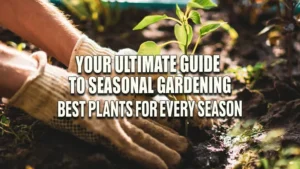

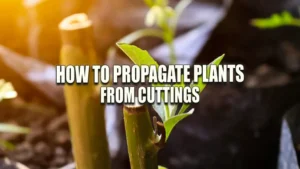
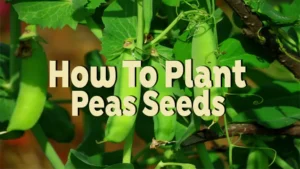

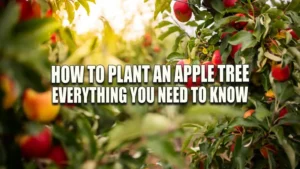
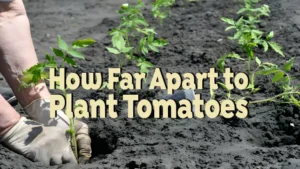

Leave your comment